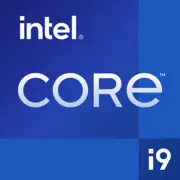Intel Core i9-11900H

Intel Core i9-11900H: Power and Balance in a Mobile Format
Processor analysis for demanding users (2025)
Architecture and Technology Process: 10 nm SuperFin and Willow Cove
The Intel Core i9-11900H processor, introduced in 2021, remains relevant in 2025 for a range of high-end laptops. It is built on the Tiger Lake architecture using the 10 nm SuperFin technology process, which ensures high transistor density and energy efficiency.
- Cores and Threads: 8 cores and 16 threads thanks to Hyper-Threading.
- Clock Speeds: Base frequency — 2.5 GHz, maximum in turbo mode — 4.9 GHz (for a single core). Under full load, all cores can boost up to 4.2 GHz.
- Cache Memory: 24 MB L3, which speeds up data processing in multi-threaded tasks.
- Integrated Graphics: Intel UHD Graphics for the 11th generation (Xe-LP architecture) with 32 execution units and a frequency of up to 1.45 GHz. Supports 4K/60 Hz and AV1 decoding.
Architecture features:
- Willow Cove: Improved IPC (instructions per clock) by 15-20% compared to the previous generation.
- PCIe 4.0: Support for 20 lanes for fast SSDs and discrete graphics.
- Thunderbolt 4: Up to 40 Gbps for connecting external devices.
Power Consumption and TDP: A Balance Between Power and Battery Life
The nominal TDP of the processor is 35 W, but in reality, under peak loads (e.g., rendering or gaming), consumption reaches 60-70 W. This requires an efficient cooling system in laptops.
Power Management Technologies:
- Intel Dynamic Tuning 2.0: Adaptively adjusts power based on load.
- Speed Shift: Quick switching between P-states to reduce latencies.
For compact devices (ultrabooks), manufacturers often limit TDP to 45 W to avoid overheating, which reduces performance but increases stability.
Performance: Real-World Usage Scenarios
Geekbench 6:
- Single-Core: 1886 (comparable to Apple M2).
- Multi-Core: 7563 (close to AMD Ryzen 7 6800H).
Office Tasks and Multimedia:
- Running 50+ tabs in Chrome, working with Excel spreadsheets with millions of rows — the processor handles it smoothly.
- 4K editing in Premiere Pro: Rendering is 30% faster than the i7-11800H, thanks to high frequencies.
Gaming:
- With iGPU: In DotA 2 (1080p, medium settings) — 45-55 FPS; Cyberpunk 2077 (720p, low) — 20-25 FPS. A discrete graphics card (e.g., RTX 3060) is needed for comfortable gaming.
- With External GPU: When paired with RTX 4070 (via Thunderbolt 4) — 60+ FPS in AAA titles at 1440p.
Turbo Boost Mode:
When temperatures are below 85°C, the processor can maintain high frequencies for 10-15 minutes, then reduces to 3.8-4.0 GHz. In gaming laptops with liquid cooling systems (e.g., ASUS ROG Zephyrus), throttling is minimal.
Usage Scenarios: Who is the i9-11900H Suitable For?
1. Professionals:
- Video editors, 3D designers, programmers (code compilation).
- Example: Dell XPS 17 (2025) for $1800 — 4K display, 32 GB RAM, 1 TB SSD.
2. Gamers:
- With RTX 4060/4070 — play Elden Ring or Starfield at high settings.
- Example: MSI GP66 Leopard (2025) — $1700, 165 Hz display.
3. General Users:
- Students, freelancers — working in Photoshop, streaming.
Battery Life: How Long Will the Charge Last?
With a TDP of 35 W and a battery capacity of 80 Wh:
- Web Surfing: 6-7 hours (brightness 50%, Wi-Fi).
- Video (1080p): 5-6 hours.
- Load (rendering): 1.5-2 hours.
Energy Saving Technologies:
- Adaptix Display: Dynamically reduces screen frequency.
- Connected Standby: Background updates while in sleep mode.
Advice: Choose laptops with a battery capacity of at least 90 Wh for more than 8 hours of autonomy in office tasks.
Comparison with Competitors
1. AMD Ryzen 9 5900HX (2021):
- Pros: Better in multi-threaded tasks (Cinebench R23: 13500 vs 12000 for i9).
- Cons: Weaker in single-core tests, no Thunderbolt 4 support.
2. Apple M2 Pro (2023):
- Pros: Battery life up to 18 hours, higher IPC.
- Cons: Limited compatibility with Windows software.
3. Intel Core i7-13700H (2023):
- Pros: +10% in multi-threading, lower heat output.
- Cons: More expensive (laptops starting at $1600).
Pros and Cons of the i9-11900H
Strengths:
- Best-in-class single-core performance.
- Support for Thunderbolt 4 and PCIe 4.0.
- Optimal for hybrid tasks (gaming + work).
Weaknesses:
- High heat output under load.
- iGPU weaker than AMD Radeon 680M.
- By 2025, competitors offer newer architectures.
Laptop Selection Recommendations
1. Device Type:
- Gaming: ASUS ROG, MSI GP/GE series — powerful cooling, discrete graphics.
- Workstation: Dell Precision, Lenovo ThinkPad P15 — ECC memory, ISV certification.
- Ultrabook: HP Spectre x360 — slim design, 90 Wh battery.
2. Key Features to Look For:
- Cooling system (minimum 2 fans + heat pipes).
- Ports: 2x Thunderbolt 4 for future upgrades.
- Display: For gaming — 144 Hz; for work — 4K IPS.
Average price of laptops with i9-11900H in 2025: $1400–$2000.
Final Conclusion
The Intel Core i9-11900H in 2025 is an excellent choice for those seeking versatility without compromise:
- Gamers will appreciate the support for powerful discrete graphics.
- Professionals will benefit from fast rendering and performance with demanding applications.
- The drawbacks of heat generation are mitigated by choosing a laptop with effective cooling systems.
Alternative: If battery life is a priority — consider laptops with Apple M3 or AMD Ryzen 7 7840U. However, for the Windows ecosystem and gaming, the i9-11900H remains a reliable option even four years post-launch.
Basic
CPU Specifications
Memory Specifications
GPU Specifications
Miscellaneous
Benchmarks
Compared to Other CPU
Share in social media
Or Link To Us
<a href="https://cputronic.com/en/cpu/intel-core-i9-11900h" target="_blank">Intel Core i9-11900H</a>